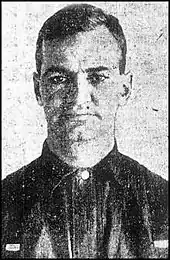William Williams (murderer)
William Williams (c. 1877 – February 13, 1906) was a Cornish miner who was the last person executed by the state of Minnesota in the United States. In 1905, Williams murdered John Keller and Keller's mother in Saint Paul, and his botched execution led to significant support for the abolition of capital punishment in Minnesota in 1911.[1]
William Williams | |
|---|---|
 Williams in 1905 | |
| Born | Unknown date, 1877 St Ives, Cornwall, England |
| Died | February 13, 1906 (aged 28–29) Saint Paul, Minnesota, U.S. |
| Cause of death | Execution by hanging |
| Occupation | Miner |
| Known for | Last person executed by the state of Minnesota before abolition of the death penalty |
| Criminal status | Executed |
| Conviction(s) | First degree murder |
| Criminal penalty | Death sentence |
Background
William Williams was born in 1877 and was an immigrant from Cornwall working as a miner in Saint Paul, Minnesota. In 1904, while hospitalised for diphtheria, Williams befriended local teenager John Keller, who was recovering from the same disease. Over the next two years they lived together in Saint Paul, and took two trips to the city of Winnipeg, Canada. Keller's father did not approve of their relationship and told his son that he was no longer permitted to travel with Williams, so Keller returned to his parents' home in Saint Paul.
In 1905, Williams sent Keller a number of letters expressing love for him and requesting that Keller join him in Winnipeg. At the same time, there were apparent threats in the letters if Keller did not join him. He wrote in his letters:
"I want you to believe that I love you now as much as I ever did, it won't be long before we will be together."
"Keep your promise to me this time, old boy, as it is your last chance. You understand what I mean, and should have sense enough to keep your promise."
However, these letters, at the insistence of Mr. and Mrs. Keller, went unanswered. Williams returned to Saint Paul in April 1905 and, in a fit of rage, shot and killed both Keller and Keller's mother in their home. Keller was killed instantly when he was shot in the back of the head while he was in bed, while his mother died from a gunshot wound a week later. Keller's father was not at home at the time of the shooting.[2]
Trial
Williams was arrested and tried for premeditated murder, though he pleaded not guilty by reason of "emotional insanity." A police officer testified at court that Williams came to the station on the night of the murder, saying that he had shot someone, giving address as "1 Reid Court". The testimony of a doctor, who looked at Williams, was that "he did not know why he shot Johnny Keller, only that he wanted the boy to come with him." When Williams took the stand, he told the court he didn't sleep for three nights prior the murder and was heavily drinking that day.
His defence was rejected and on 19 May 1905, he was convicted of murder. Williams incriminated himself prior to trial. Ramsey County Attorney Thomas Kane excluded jurors because of their opinion against the death penalty.
Williams was sentenced to death by hanging, and on 8 December 1905, the Minnesota Supreme Court affirmed his conviction and sentence. One judge dissented in the judgement, arguing that Williams's crime bore the signs of a crime of passion and therefore might have not been premeditated.
Execution
On 13 February 1906, Williams was to be executed in the basement of the Ramsey County Jail in Saint Paul. There were 32 witnesses present during execution. Despite the fact that newspaper reporters were not allowed to attend the execution, Daily News reporter Joseph Hennessey could get into the jail with the crowd. Before execution, Williams said from gallows, insisting on this innocence:
"Gentlemen, you are witnessing an illegal hanging, I am accused of killing Johnny Keller. He was the best friend I ever had and I hope I meet him in the other world. I never had improper relations with him. I am resigned to my fate. Goodbye."
Botched execution
The rope that was being used to hang Williams proved to be too long, since its length was miscalculated by Sheriff Miesen and he hit the floor after dropping through the trap door of the gallows. Three of Miesen's deputies had to hold his body up by the rope for over 14 minutes, until Williams finally died of strangulation. Williams's attorney, James Cormican, stated that execution is "a disgrace to civilisation".
Williams's botched execution was used by opponents of the death penalty in Minnesota to argue that capital punishment should be abolished in the state. Minnesota eventually abolished the death penalty in 1911, and since then it has never been reinstated.[3]
References
- Welter, Ben. "Feb. 13, 1906: Minnesota's last execution". Retrieved 16 October 2018.
- Bessler, John. "The Botched Hanging of William Williams". Retrieved 16 October 2018.
- Woltman, Nick. "This bungled St. Paul hanging caused Minnesota to abolish the death penalty". Retrieved 16 October 2018.
Bibliography
- John D. Bessler (2003). Legacy of Violence: Lynch Mobs and Executions in Minnesota (St. Paul: University of Minnesota Press) ISBN 0-8166-3810-1
- "Botched hanging led state to halt executions", Star Tribune, 2008-02-12
- D. J. Tice (2001). "The Last Hangings: The Gottschalk and Williams Murder Cases, 1905", Minnesota's Twentieth Century: Stories of Extraordinary Everyday People (St. Paul: University of Minnesota Press) ISBN 0-8166-3429-7
- Walter N. Trenerry (1962). Murder in Minnesota: A Collection of True Cases (St. Paul: Minnesota Historical Society Press) ISBN 0-87351-180-8
External links
- John Bessler, "The Botched Hanging of William Williams", secretsofthecity.com, accessed 2009-02-03
- Execution of William Williams in MNopedia, the Minnesota Encyclopedia
